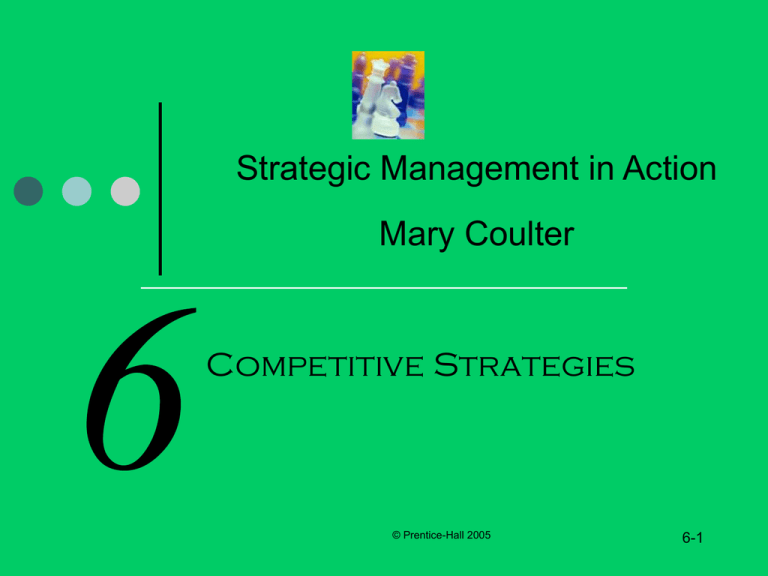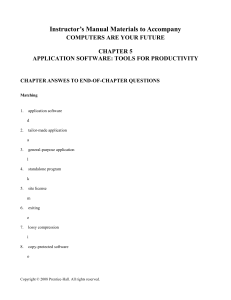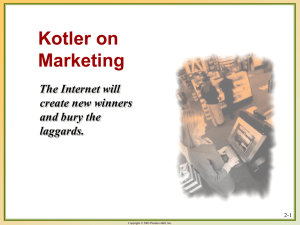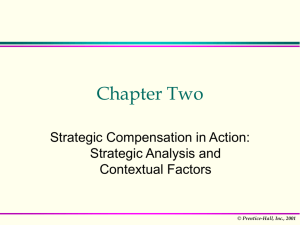Strategic Management in Action Mary Coulter
advertisement

Strategic Management in Action Mary Coulter Competitive Strategies © Prentice-Hall 2005 6-1 Learning Outline What is competitive advantage and how do we get it? Explain the importance of competitive advantage. Describe how an organization’s competitors can be determined. Discuss how resources, capabilities, and core competencies lead to competitive advantage. Explain the relationship between competitive advantage and competitive strategies. © Prentice-Hall 2005 6-2 Learning Outline (contd.) What are the competitive strategies? Describe Miles and Snow’s adaptive strategies. Describe Abell’s business definition framework and his competitive strategies. Describe Porter’s generic competitive strategies. Explain what is meant by “stuck in the middle.” Describe an integrated low-cost differentiation strategy. Explain Mintzberg’s generic competitive strategies. © Prentice-Hall 2005 6-3 Learning Outline (contd.) Implementing, evaluating, and changing competitive strategy Describe how an organization’s competitive strategies are implemented, evaluated, and changed. Explain what role functional strategies play in an organization’s competitive strategies. Discuss the various competitive postures and actions an organization can take. © Prentice-Hall 2005 6-4 Competitive Advantage Key concept of strategic management Sets an organization apart What competitive strategies are designed to exploit Implies other competitors Can be eroded easily and quickly by competitors © Prentice-Hall 2005 6-5 Understanding the Competitive Environment What is competition? When organizations battle for some desired object or outcome Who are our competitors? Industry perspective Market perspective Strategic groups perspective © Prentice-Hall 2005 6-6 Figure 6.2 Industry and Market Approaches to Defining Competitors Industry Market Same Product-Service Customer Needs Number of Sellers Degree of Differentiation One Pure Monopoly Low Few Pure Oligopoly Low Few Differentiated Oligopoly Many Monopolistic Competition High Many Pure Competition None © Prentice-Hall 2005 Medium 6-7 Table 6.1 Possible Strategic Dimensions for Identifying Strategic Groups • • • • • • • • • • • Price Quality Level of vertical integration Geographic scope Product line breadth-depth Level of diversification R&D expenditures Market share Profits Product characteristics Any other relevant strategic factor © Prentice-Hall 2005 6-8 Figure 6.3 Strategic Groups: Cosmetics Industry Distribution Strategy Selective Department Store MassDiscount Group E Avon Mary Kay Origins The Body Shop Group F Elizabeth Arden Chanel Christian Dior Group C Estée Lauder Clinque Color Me Beautiful Zhen Chantel L’Oreal Group B Group A Revlon Maybelline Ultima Cover Girl Prescriptives Almay Max Factor Sally Hansen Coty Bonne Bell Wet ’n Wild Low Medium Price Strategy © Prentice-Hall 2005 Group D Adrian Arpel Charles of the Ritz Lancôme High 6-9 The Role of Resources and Distinctive Capabilities in Gaining Competitive Advantage Every organization has resources and capabilities to do whatever it’s in business to do Some organizations “can do,” others “can’t do” Competitive advantage implies gaining the edge on others Organizations strive for sustainable competitive advantage and set the stage for competition – intense, moderate, or mild. © Prentice-Hall 2005 6-10 Competitive Strategy Exploits competitive advantage By finding ways to use resources and distinctive capabilities Which sets the organization apart from its competitors © Prentice-Hall 2005 6-11 What are the Competitive Strategies? Contrary to expectations, the number of ways to define competitive strategy are limited Traditional approaches New perspectives © Prentice-Hall 2005 6-12 Table 6.2 Characteristics of Miles and Snow’s Adaptive (Competitive) Strategies Strategy Characteristics Prospector • Organization seeks innovation • Demonstrated ability to survey dynamic environment and develop new products-services to fit the changing environment • Frequently and continually innovating, developing, and testing new products-services • Competitors are uncertain about prospector’s future strategic decisions and actions Defender • Searches for market stability • Produces only a limited product line for a narrow segment of total potential market • Seeks to protect (defend) its well-established business • Does whatever is necessary to aggressively prevent competitors from entering their turf • Can carve out and maintain niches within its industry that competitors find difficult to penetrate © Prentice-Hall 2005 6-13 Table 6.2 (contd.) Characteristics of Miles and Snow’s Adaptive (Competitive) Strategies Strategy Characteristics Analyzer • Strategy of analysis and imitation • Thoroughly analyzes new business ideas (products, services, markets) before deciding to jump in • Watches for and copies the promising and successful ideas of prospectors Reactor • • • • Lacks coherent strategic plan Simply reacts to environmental changes Makes strategic adjustments only when finally forced to do so Unable to respond quickly to environmental changes because resourcescapabilities are lacking or are not developed or exploited properly © Prentice-Hall 2005 6-14 Abell’s Business Definition Framework A business can be defined using three dimensions Customer groups – who we’re going to serve Customer needs – what customer need we’re attempting to meet Technology or distinctive competencies – how need is met © Prentice-Hall 2005 6-15 Figure 6.4 Abell’s Competitive Strategies Level of Market Segment Differentiation High Broad None Differentiated Undifferentiated Competitive Market Scope Narrow Focus © Prentice-Hall 2005 6-16 Porter’s Generic Competitive Strategies Competitive advantage comes from only 1 of 2 sources Having the lowest costs in the industry Possessing significant and desirable differences from competitors The second factor is the scope of product-market Mix of these factors provide the basis for: Cost leadership strategy (or low-cost strategy) Differentiation strategy Focus strategy © Prentice-Hall 2005 6-17 Figure 6.5 Porter’s Generic Competitive Strategies Competitive Advantage Low Costs Product-Service Differences Broad Cost Leadership Differentiation Narrow Focus (Cost) Focus (Differentiation) Competitive Market Scope © Prentice-Hall 2005 6-18 Contemporary Perspectives on Competitive Strategy Newer perspectives provide an expanded, and perhaps more realistic, description of what competitive strategies organizations are using Integrated low-cost differentiation strategy Mintzberg’s generic competitive strategies © Prentice-Hall 2005 6-19 Figure 6.7 Mintzberg’s Generic Competitive Strategies By Price By Marketing Image By Product Design Differentiation By Product Quality By Product Support Undifferentiated © Prentice-Hall 2005 6-20 Implementing Competitive Strategy Without implementation a strategy is nothing more than an idea Implementing competitive strategies The role of functional strategies • What strategy is most appropriate? • How is that strategy implemented? Competitive postures and actions • Offensive moves • Defensive moves © Prentice-Hall 2005 6-21 Evaluating and Changing Competitive Strategy Responsibility of managing strategically doesn’t stop after implementation Evaluation of competitive strategy assesses: Various functional areas Activities performed in those areas Change when evaluation shows the strategy • Doesn’t have the intended impact • Hasn’t resulted in desired levels of performance © Prentice-Hall 2005 6-22 Chapter Six Questions © Prentice-Hall 2005 6-23








